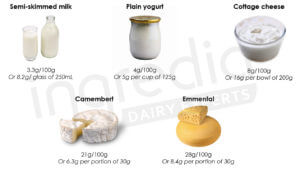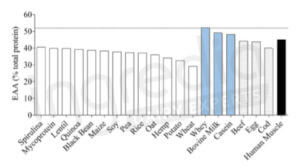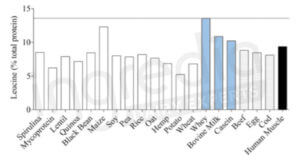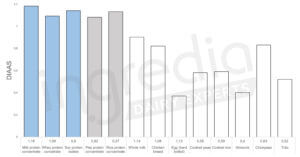How can dairy products substitute meat products?
11 May 2020
Because of environmental reasons, economics, or health, the current food trend is reduction of meat consumption. A lot of diets with little or no meat are very popular for several years. The most commons are flexitarianism (big reduction of meat consumption), vegetarianism (meat exclusion) or veganism (exclusion of all animal-based products). Therefore, according to a 2018 study conducted by the Credoc, consumption of meat products fell by 12% in France in only 10 years.1
However, for a lot of us, meat is or was our main proteins source. So, it is necessary to find different substitutes in order to provide our nutritional requirements. This is how dairy products can be a great substitute for flexitarian and vegetarian people!
Are dairy products good proteins source?
To answer this question, the best way is to look at a nutritional food composition table such the Ciqual, the French table from the ANSES.2 Data in figure 1 are taken from this database.

Figure n°1 : Protein amount in different portions of dairy products.2
If we compare data from figure with those of a meat product, for example a ground beef steak of 100g: it contains between 20 and 25g of proteins. A portion of Camembert (6.3g proteins) with a cottage cheese bowl of 200g (16g proteins) provide 22.3g of proteins. It represents as much proteins as the ground beef steak. Therefore, dairy products are a good proteins source to substitute meats.2
Are milk proteins of good quality?
Yes, they are proteins of excellent quality. Like meat proteins, they contain all the amino acids that make up our body’s proteins. As shown in figure 2 from a 2015 Journal of Nutrition article, they contain all essential amino acids A in good proportions: with 52g/100g of proteins, whey proteins are the higher in essential amino acids. Casein are in second position (48g/100g) just before beef or eggs (44g/100g). 3

Figure n°2 : Essential amino acids (EAA) concentration of different proteins sources.3
White bars correspond to plant-based proteins, blue bars are milk proteins, grey bars are the other animal-based proteins (meat, fish, egg) and the black bar correspond to human muscle. The horizontal dashed line represents the highest concentration of essential amino acids found in the study, namely whey protein.
Are all essential amino acids as important?
Yes, they are. An essential amino acid can inherently not be synthesized by the body. The lack of any of them could have adverse effects on the body.
However, among these, an amino acid is particularly important to stimulate muscle protein synthesis: Leucine. This can be very interesting for athletes or elderly people.3 4 5 For more information about the interest of Leucine to stimulate anabolism B, take a look at our article “What is the perfect protein for the elderly people?” .
Figure 3 represents Leucine concentration of different proteins sources. We can see that milk proteins are the best Leucine source (11.7% for whey protein and 9.2% for caseins*). So, these proteins are perfectly adapted to people who want to maintain or strengthen their muscle mass.3

Figure n°3 : Leucine concentration in different proteins sources.3
Is the essential amino acids content the only parameter to be taken into account when judging the quality of a protein?
No, it is not. There is an indicator to evaluate the quality of a protein: the DIAAS (Digestible Indispensable Amino Acid Score). For a given protein, it considers the essential amino acids composition and the digestibility C of each of them.6 7 For more information about the DIAAS, do not hesitate to read our article dedicated to the quality of proteins.
According to the figure 4, which comes from a 2017 study conducted by S. Phillips, whole milk has a DIAAS about 1.14. In comparison, chicken breast has a DIAAS of 1.08 and beef meat is around 1.0 (DIAAS depends on digestibility of each essential amino acid of the protein, the cooking method of the meat can influence this data).8 9 The more a food has a high DIAAS, the more digestible the proteins it contains are, and the more it corresponds to the nutritional requirements. Consequently, we can note that milk proteins represent an excellent substitute to meat products.

Figure n°4 : DIAAS of different foods and ingredients.8
White bars correspond to plant-based proteins, blue bars are milk proteins, grey bars are the other animal-based proteins (meat, egg).
Furthermore, figure 4 shows the two main drawbacks of plant-based proteins: on one hand they are globally not complete, on the other hand they are less digestible. That is the reason why these proteins never exceed a DIAAS of 1.0. For example, rice proteins are short of Lysine and Threonine, two essential amino acids not very present in cereals (particularly Lysine).10 And the digestibility of these proteins is about 55 to 65%.11 That is why DIAAS of cooked rice is only 0.59.12
Nevertheless, plant-based proteins should not be ignored. They can be better than meats on certain point, as figure 3 shown: maize has an excellent Leucine concentration (12.2%) which is nearly 40% higher than beef protein (8.8%).3 However, the lack of other essential amino acids can limit the previously mentioned beneficial effects of Leucine. It is therefore important to always vary its protein sources to properly cover its nutritional needs.
Compare to other proteins, only the benefits of milk proteins are presented. Are they really any better?
The answer is obviously no, there is no perfect food. Then, red meats retain an undeniable advantage: their high iron content.13 Red meats is one of the best iron sources of the traditional diet since 100g of cooked food cover 18 to 26% of iron daily needs. D On his side, milk only contains a very negligible amount of iron.14
Nevertheless, vegetarians can cover their iron needs with foods such as lentils. By comparison, 100g of cooked greed lentils can satisfy 15 to 22% of daily iron requirements (however, the bioavailability E of iron from plants is less important than iron from meats).2
Nota bene: Anemia, i.e. the lack of hemoglobin whose cause is multiple but often due to a lack of iron (dietary deficiency or malabsorption), concerns nearly a quarter of the world population (1.62 billion people) according to 2008 data from the WHO.15 If we choose to not consume meat anymore, then it is important pay attention to its daily consumption of iron and to focus on foods that provide enough iron (oilseed and legumes) and, if necessary, opt for iron rich food supplements (such as Lactoferrin).
However, concerning vitamins and minerals, milk is also very interesting: as beef meat, it is a good source of Phosphorus, Potassium, and vitamins B2, B5 and B12. Moreover, milk contains even more Calcium and vitamins B1 and B9.2 13 16
But in the end, how do you replace meat when you are used to having it on your plate?
For a lot of us, food traditions are rooted in our culture: a complete dish consists of meat and its sides (vegetables and starchy foods). But today, products imitating the look, the texture and sometimes even the taste of meat have appeared. These are meat analogues, or steak type. The best know are plant-based proteins steak type (soybeans, cereals, chickpeas, etc.) but is not uncommon for milk proteins to complement these meat analogues, particularly by addition of cheese. It is also possible to create meat analogue entirely with milk.
To conclude this article, it is perfectly possible to substitute meat products with a variety of animal-based (eggs and dairy products) and plant-based foods (cereals, legumes, oilseeds) to meet its protein requirements. Varying the sources ensures to cover its intake in all essential nutrients (amino acids, fatty acids, vitamins, minerals, etc.). That is the reason why the PNNS (French National Nutrition Health Plan) recommends a balance of 50% animal-based proteins and 50% plant-based proteins. In this sense, the new meat analogues composed of plant-based proteins and cheese appear to be a very good compromise.
For more information, please contact us
Authors: Rémi Maleterre & Audrey Boulier.
*A [Essential Amino Acids]: Amino acid that the body cannot synthesize. Therefore, they must be supplied through the diet
*B [Anabolism]: Muscular proteins synthesis.
*C [Digestibility]: For a given nutrient, this is the amount actually ingested available to the body after digestion and absorption. It can be expressed as a percentage.
*D [Daily iron requirements]: According to the ANSES, daily iron requirements are 11mg for men and postmenopausal women, and 16mg for premenopausal women
*E [Bioavailable]: relating to the absorption and used of a nutrient by the body. The more bioavailable a nutrient is, the more it is absorbed and used by the body.
*data for Leucine correspond to those measured in Prodiet® 90S for whey proteins and Prodiet® Fluid for micellar caseins. These products are developed by Ingredia.
_________________________________________________________________________________________
[1] Gabriel Tavoularis and Éléna Sauvage, “Les nouvelles générations transforment la consommation de viande,” Crédoc, September 1, 2018, https://www.credoc.fr/publications/les-nouvelles-generations-transforment-la-consommation-de-viande.
[2] ANSES, “Ciqual French Food Composition Table,” accessed April 7, 2020, https://ciqual.anses.fr/#.
[3] Stephan van Vliet, Nicholas A. Burd, and Luc J. C. van Loon, “The Skeletal Muscle Anabolic Response to Plant- versus Animal-Based Protein Consumption,” The Journal of Nutrition 145, no. 9 (September 2015): 1981–91, https://doi.org/10.3945/jn.114.204305.
[4] Imanipour Vahid et al., “The Effects of Branch-Chain Amino Acids on Fatigue in the Athletes,” Interventional Medicine & Applied Science 10, no. 4 (n.d.): 233–35, https://doi.org/10.1556/1646.10.2018.10.
[5] Chad M. Kerksick et al., “ISSN Exercise & Sports Nutrition Review Update: Research & Recommendations,” Journal of the International Society of Sports Nutrition 15, no. 1 (August 1, 2018): 38, https://doi.org/10.1186/s12970-018-0242-y.
[6] Food and Agriculture Organization of the United Nations, ed., Dietary Protein Quality Evaluation in Human Nutrition: Report of an FAO Expert Consultation, FAO Food and Nutrition Paper 92 (FAO Expert Consultation on Protein Quality Evaluation in Human Nutrition, FAO, 2011).
[7] Gertjan Schaafsma, “The Protein Digestibility–Corrected Amino Acid Score,” The Journal of Nutrition 130, no. 7 (July 1, 2000): 1865S-1867S, https://doi.org/10.1093/jn/130.7.1865S.
[8] Stuart M. Phillips, “Current Concepts and Unresolved Questions in Dietary Protein Requirements and Supplements in Adults,” Frontiers in Nutrition 4 (2017): 13, https://doi.org/10.3389/fnut.2017.00013.
[9] Suzanne M. Hodgkinson et al., “Cooking Conditions Affect the True Ileal Digestible Amino Acid Content and Digestible Indispensable Amino Acid Score (DIAAS) of Bovine Meat as Determined in Pigs,” The Journal of Nutrition 148, no. 10 (October 1, 2018): 1564–69, https://doi.org/10.1093/jn/nxy153.
[10] V. R. Young and P. L. Pellett, “Wheat Proteins in Relation to Protein Requirements and Availability of Amino Acids,” The American Journal of Clinical Nutrition 41, no. 5 Suppl (1985): 1077–90, https://doi.org/10.1093/ajcn/41.5.1077.
[11] Kunlun Liu, Jiabao Zheng, and Fusheng Chen, “Effect of Domestic Cooking on Rice Protein Digestibility,” Food Science & Nutrition 7, no. 2 (January 24, 2019): 608–16, https://doi.org/10.1002/fsn3.884.
[12] Brigid McKevith, “Nutritional Aspects of Cereals,” Nutrition Bulletin 29, no. 2 (2004): 111–42, https://doi.org/10.1111/j.1467-3010.2004.00418.x.
[13] ANSES, “Ciqual Table de Composition Nutritionnelle Des Aliments – La Viande Rouge, Cuite (Aliment Moyen),” accessed March 24, 2020, https://ciqual.anses.fr/#/aliments/6585/viande-rouge-cuite-(aliment-moyen).
[14] “Le Fer | Anses – Agence Nationale de Sécurité Sanitaire de l’alimentation, de l’environnement et Du Travail,” accessed March 24, 2020, https://www.anses.fr/fr/content/le-fer.
[15] Bruno De Benoist, World Health Organization, and Centers for Disease Control and Prevention (U.S.), Worldwide Prevalence of Anaemia 1993-2005 of: WHO Global Database of Anaemia (Geneva: World Health Organization, 2008), http://whqlibdoc.who.int/publications/2008/9789241596657_eng.pdf.
[16] ANSES, “Ciqual Table de Composition Nutritionnelle Des Aliments – Le Lait, Teneur En Matière Grasse Inconnue, UHT (Aliment Moyen),” accessed March 19, 2020, https://ciqual.anses.fr/#/aliments/19039/lait-teneur-en-matiere-grasse-inconnue-uht-(aliment-moyen).